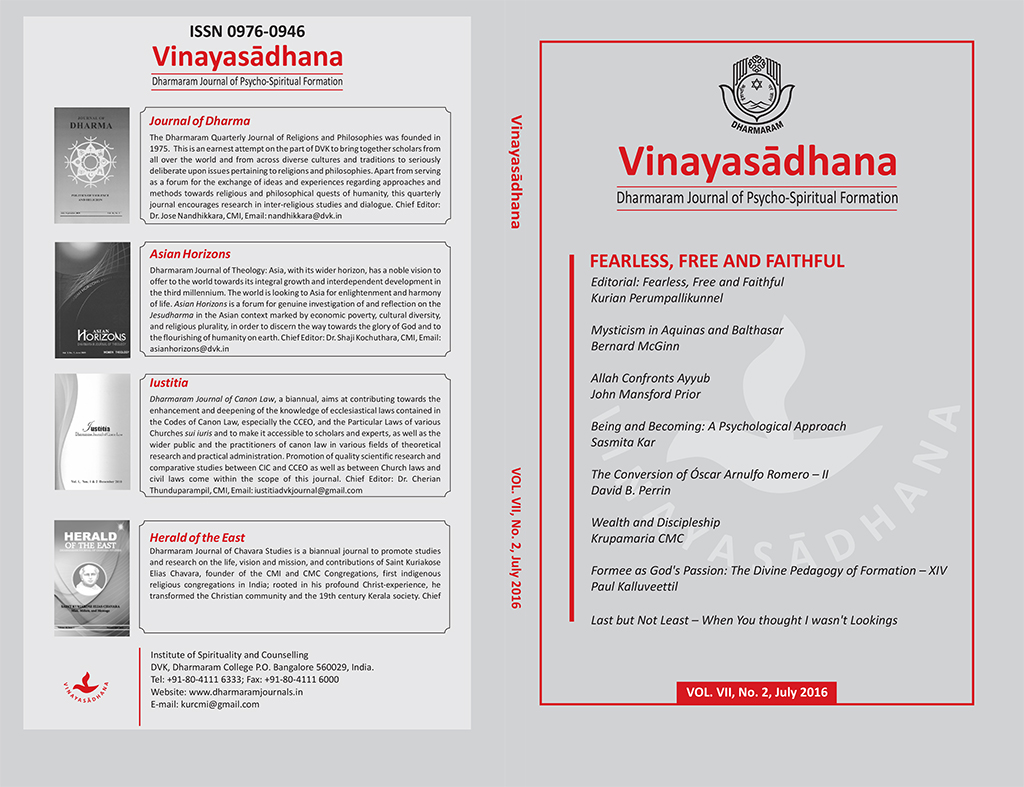Being and Becoming
A Psychological Approach to the Concept of Self According to Buddhism and Bhagavadgita
Keywords:
Bhagavadgita, Buddhism, Being and Becoming, Concept of Self, Psychological ApproachAbstract
It is the fundamental right of all human beings to live a happy and successful life. Nevertheless, despite every effort to avoid it, suffering sets in. In fact, this suffering is the result of our failure to open to the vastness of life. We are debilitated by our limited knowledge and remain blind to things that are beyond our knowledge. In our quest for materialistic goals and ritualistic loftiness, human beings forget that life needs certain basic qualities to make the world a better place to live and evolve. Hinduism, represented by Bhagavadgita, and Buddhism are undoubtedly the two most outstanding philosophical and religious traditions of India. They still remain vibrant living religious traditions that played and continue to play significant roles in the lives of countless individuals by showing them the path towards better living and help them to evolve their selves to the highest extent possible. A blending of the vision of Srimad Bhagavadgita and the compassionate heart of the Buddhism can contribute immensely towards the achievement of this goal.
References
Anattalankana Sutta, Discourse on the Definition of Not Self, Mahabhvaga, Samyutta Nikaya III.66
Brown, B.E. (2004) The Buddha Nature: A study of the Tathagarbha and Alayavijnana, Reprint. Delhi: Motilal Banarsidass Publishers Pvt. Ltd. P.56.
Clarke, J.J. (1997) Oriental Enlightenment: The Encounter between Asian and Western Thought. United Kingdom: Psychology Press.
Freud, S. (1933) New Introductory Lectures on Psychoanalysis. (Penguin Freud Library 2) pp. 105–6
Fuller, P. (2005) The Notion of Dhitthi in Theravada Buddhism: The Point of View. New York: Routledge Curzon.
Ireland, J.D. (2006) Samyutta Nikaya: An Anthology. III,66. India: Buddhist Publication Society
Jiang, Tao (2006) Yogacara Buddhism and Modern Psychology on the Subliminal Mind University of Hawai’s press
Keown, D. (2000) Buddhism: A Very Short Introduction. Oxford University Press.pp. 36-37
Krishnah, O.N. (2004) In Search of Reality: A Layman’s Journey through Indian Philosophy. Motilal Banarsidass.
Krishann, O.N. (2004) In Search of Reality. Delhi: Motilal Banarsidass Publishers Pvt. Ltd.
Krishnan,O.N. (2008) The Bhagavata Gita & Buddhism. Bhopal: UBS Publishers Pvt. Ltd.
Ramsukhdas, S. (2014a,14th ed.) Srimad Bhagavat Gita. Gorakhpur: Gita Press. p.ix.
Ramsukhdas, S. (2014b,14th ed.) Srimad Bhagavat Gita. Gorakhpur: Gita Press. p.ix.
Ramsukhdas, S. (2014c,14th ed.) Srimad Bhagavat Gita. Gorakhpur: Gita Press. p.ix-x.
Samutta Nikaya (Dukhatta Sutta). 45. 165
Samyutta Nikaya II: 12:1) Quoted by O.N. Krishnan (2004). In Search of Reality: A layman’s journey through Indian philosophy. Delhi: Motilal Banarsidass Publishers Pvt. Ltd. p. 169
Smetham, G. (2015) Quantum Path to Enlightenment. Brighton: Sussex Academic Pub.
Silva, P. de., (1992) Buddhist and Freudian Psychology. United Kingdom: NUS Press.
Svarghese, A. P. (2008) India: History, Religion, Vision and Contribution to the World. New Delhi: Atlantic Publishers and Distributers.p.259-60.
Thera, N. (1996) Buddha Dhamma: Life and Teachings of the Buddha. New Delhi: Asian Educational Services.
Upadhyaya, K.N. (1998) Early Buddhism and the Bhagavadgita (reprint). Delhi: Motilal Banarsidass Publishers Pvt. Ltd.
Wettimuny, R.G.de S. (1962) Buddhism and its relation to Religion and Science. Colombo: M.D. Gunasena and Co Ltd. p. 166/167.


